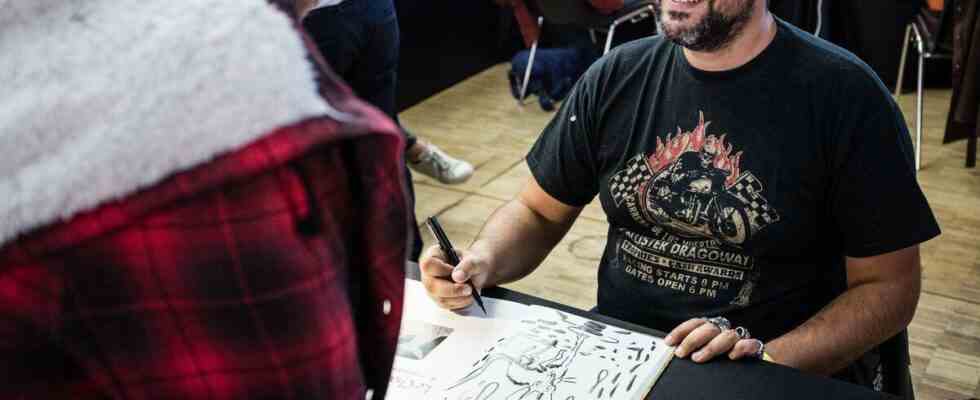In the beginning, there was the verb. And a cat. It was 20 years ago, and even if it was not really the beginning of Joann Sfar’s career, it was the beginning of a popular success that has never been denied. The eleventh volume of Rabbi’s cat– or the adventures of a talking cat and his master, a rabbi in Algiers in the 1930s – comes to crown this 20th anniversary that the author wanted to celebrate as it should. ” The Rabbi’s Cat has become a kind of classic without me doing it on purpose. Marking this anniversary is a good way to ask questions about the status of these characters, to think about the format, the readership… There are faithful people but there are also people who are discovering him today. I have to keep wondering how to address everyone. I know success is fragile. »
This is also why Joann Sfar does not sulk his pleasure to go at the Paris Book Festival to celebrate this anniversary: ”I’m always happy to go to the salon, to meet people. I am very sociable and cheerful. As a comic book author, you spend a lot of time alone. In the salon, I chat with people who have sometimes followed me for thirty years. It’s very pleasant and it makes me proud to discuss with people who read my books, who discovered reading with my comics, who have anecdotes with them… There are incredible stories and encounters. »
“My inspiration is the fabulous folklore of CM2 readings”
However, the success of Rabbi’s cat, did not flow naturally. “At first, comics were received as a philosophical or educational work, because the cat and the rabbi discuss religion, morals… Me, I didn’t see it like that at all, recalls Joann Sfar. From my point of view, these are books about the family, its comedies and its disputes. My inspiration is the fabulous folklore of CM2 readings: Marcel Pagnol, La Fontaine, the Renard novel…”
With its joyful and colorful tribulations (and a little philosophical all the same, no offense to its author), The Rabbi’s Cat became a bookstore success and a comic strip classic which, as Joann Sfar admits, “requires it”. “I have a pact with the readership. It should never be The Rabbi’s Cat become harmless, but not offensive either. You should never leave the family table… A cat album should be debated, pose small problems. In general, when I start an album I say to myself “I can’t talk about that…” And that’s always the theme that I finally choose. »
Re-enchant North African memory
With its stories of tolerance and listening, the anniversary of the Rabbi’s cat resonates with political news and the continued rise of far-right and exclusionary ideas. Committed author, and sometimes loudmouth, Joann Sfar does not want, however, to make his hero the defender of a humanist cause. “Twenty years ago, society was tense, tense. I did not want, with these albums, to create conflict. On the contrary… I wanted to stage a place of sharing, a common good. I also wanted to show Algiers, where I’ve never set foot, and re-enchant North African memory. »
Three events presided over the birth of the Rabbi’s cat : the attacks of September 11, 2001, the death of the author’s grandmother, and the birth of his daughter. “We were predicted a clash of civilizations that I refused. I thought about the cultural memory of my Algerian grandmother that I would like to pass on to my daughter. »
“I don’t identify with any or all of them”
Over time, Joann Sfar has, of course, matured with her characters. “At first, I was on the cat side, defiant and sarcastic. As I get older, I better appreciate his master’s temperance, his good nature, and I give good dialogue to his daughter… I don’t identify with any or all of them. This family is my imaginary theater troupe to say what goes through my head. »
And to help readers understand “what goes through his head”, Joann Sfar wrote his first autobiography. A large album “drawn and colored like a Rabbi’s cat which will tell of my childhood in Nice. I show my real family there. Maybe people will understand what I meant in my albums by reading this one…”

